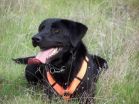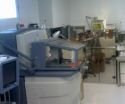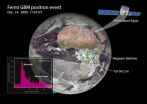(Press-News.org) Berkeley — It will come as no surprise to dog owners that their four-legged friends have a flair for sniffing out the excrement of other animals. Now, biologists at the University of California, Berkeley, have trained dogs to detect the scat of other critters for the greater good – to conduct more accurate surveys of wildlife.
"Wildlife detection dogs have been mostly used in airports to detect contraband, including endangered species and wildlife products, but in recent years, interest has grown in using the dogs to help scientists track biological targets in natural settings," said Sarah Reed, lead author of a paper documenting the dogs' performance that is published in the January issue of the Journal of Wildlife Management. "Working with dogs can greatly improve our ability to detect rare species and help us to understand how these species are responding to large-scale environmental changes, such as habitat loss and fragmentation."
Reed conducted the research while she was a graduate student in UC Berkeley's Department of Environmental Science, Policy and Management. She worked with study co-author Aimee Hurt, co-founder and associate director of Working Dogs for Conservation, a Montana-based nonprofit organization that promotes the training and use of dogs as a non-invasive tool for wildlife studies and management.
"Once the ability to extract and analyze DNA improved, researchers recognized the value of scat as a way to non-invasively monitor the location and population size of key species," said Hurt. "With scat, you can confirm the ID of species and even individuals, as well as analyze hormone levels and diet. It's a very valuable data deposit. So then it became a matter of finding ways to better track the scat, and dogs naturally came to mind."
But as with other tools and techniques used in science, the researchers wanted to calibrate the use of dogs in wildlife surveys.
"We wanted to record how far away dogs can detect the scat, and to determine how that is influenced by factors in the environment, such as wind direction, humidity and temperature," said Reed, who is now a post-doctoral fellow at Colorado State University's Department of Fish, Wildlife, and Conservation Biology. "One of the things we're trying to do is help design tests and create metrics that could be used to evaluate dogs as part of a certification program."
The researchers searched animal shelters and rescue organizations in Northern California for candidate dogs to train. "The dogs that do really well in this type of work are high energy, which also makes them hard to live with as pets," said Hurt. "Those are often the types of dogs that end up in shelters. They are not kennel dogs. They need a job."
In the end, only one out of every 200-300 dogs is considered a candidate, she said, and of those, only 40 percent make the final cut. It takes anywhere from six weeks to three months to get the dogs ready for field work.
For this study, two dogs emerged from more than 600 candidates. A female Labrador retriever mix was trained to detect the scat of mountain lions (Puma concolor), bobcats (Lynx rufus) and domestic cats, and a male pit bull terrier mix was trained to detect red fox (Vulpes vulpes), gray fox (Urocyon cinereoargenteus) and kit fox (Vulpes macrotis) scat. When the dogs correctly located a target species' scat, they were rewarded with a play session.
Researchers obtained the sample scat from zoos and animal rehabilitation centers throughout California. For each species, the researchers collected scat from several individuals fed a variety of diets. This ensured that the dogs were cued to the species' scent rather than to what the animals ate.
The training and trials took place at the Hopland Research and Extension Center, a UC research field station in Mendocino County.
In a typical wildlife survey, a human researcher follows established paths called transect lines. For this study, the researchers placed scat at various distances from those lines and used GPS coordinates to keep track of them. Both scat-sniffing dogs were able to detect samples placed 10 meters (33 feet) from the line at least 75 percent of the time. Even at distances of 25 meters (82 feet) from the line, the dogs were able to detect scat 30 to 40 percent of the time.
In contrast, the researchers estimated that humans in the same environment would be limited to visual searches and only manage to see scat 3-5 feet from the line.
Wind did not have a significant effect on detection rates, possibly because the dogs were allowed the freedom to search for scents from multiple directions.
Of the environmental factors studied, precipitation had the biggest influence on detection rates. During the winter rainy season (November-April), the dogs were less likely to detect scat the longer the excrement was out in the rain. During the summer dry season (May-October), the scat accumulated over time, and the dogs detected it in greater numbers.
"Because of the potential for these environmental factors to bias results, at a minimum we recommend that researchers report the conditions under which wildlife detection surveys took place and analyze whether detection rates vary as a function of temperature, humidity, wind, precipitation and other locally-important environmental factors," said Reed.
The study authors also recommend that wildlife surveys be designed to maximize the abilities of the detection dog. For instance, tolerance to heat varies among individual dogs, which may explain why air temperature affected the dogs in this study differently, the authors said. Hotter temperatures slightly increased detection rates for the Labrador retriever mix, but they decreased rates for the pit bull terrier mix.
"A dog can't smell as well when it's panting, so dogs that do not tolerate heat will have decreased performance on hot days," said Reed.
The researchers suggested that, to assess detection distances and environmental thresholds of individuals dogs, controlled search trials should be conducted under a variety of conditions similar to those in the experiments described in the paper. This information will allow researchers to calibrate their survey design to suit individual dogs' abilities.
"Dogs aren't machines, they can't be turned off and placed on the shelf, and they vary as individuals," said Hurt. "They come with unique strengths: They are very mobile, they are able to problem-solve, they are able to learn and adapt. But when designing a study, these strengths produce challenges, such as how well the dogs can be expected to work in this environment, and how to know how much area they are effectively searching. This paper is among the few that contribute to addressing these questions."
INFORMATION:
Other UC Berkeley co-authors on the paper are Wayne Getz, professor, and Allison Bidlack, a former graduate student, both from UC Berkeley's Department of Environmental Science, Policy and Management.
Wildlife biologists use dogs' scat-sniffing talents for good
2011-01-12
ELSE PRESS RELEASES FROM THIS DATE:
Nanodisk gene therapy
2011-01-12
One of the challenges of gene therapy - a set of methodologies aimed at treating several nucleic acid diseases (DNA or RNA) - is to assure that this material arrives directly to the nucleus of the cell without losing a substantial amount along the way and without producing any undesired side effects. With this aim, scientists experiment with the use of different types of vectors, molecules capable of transporting genetic material to the correct place. Presently, natural "deactivated" viruses are the most commonly used vectors in clinical trials, their side effects however ...
New markers for allergic disorders thanks to analysis of medical databases
2011-01-12
Researchers at the University of Gothenburg, Sweden, have developed new methods for analysing medical databases that can be used to identify diagnostic markers more quickly and to personalise medication for allergic disorders. They could also reduce the need for animal trials in clinical studies.
Published in the journal PLoS Computational Biology, the study builds on data analyses of freely available medical databases representing studies of countless numbers of patients in the
PubMed database, and microarray data in another major database. The use of microarrays is ...
Winter sports threaten indigenous mountain birds
2011-01-12
In the winter months, the mountain ranges of central Europe attract thousands of tourists for skiing, snowboarding and other outdoor sports, but conservationists fear this annual invasion may threaten indigenous bird species, including the Capercaillie. The research, published in the journal IBIS, reveals how the growth of human recreation may be a key factor in the rapidly declining population of these iconic alpine birds.
The Capercaillie (Tetrao urogallus), also known as the Wood Grouse, is the largest member of the grouse family and is renowned for its mating display. ...
Consumption Report 2010: Swedes' alcohol consumption is falling
2011-01-12
Swedes drink less and less alcohol while at the same time the Swedish Alcohol Retail Monopoly's sales
are rising and statistics from Statistics Sweden show that alcohol consumption is on the increase. This
has been the trend for a long period of time. Statistics from the Centre for Social Research on Alcohol
and Drugs, SoRAD, show that alcohol consumption fell continuously in the period from 2004 to 2009,
whereas the Swedish Alcohol Retail Monopoly's sales rose by 22% over the same period. The Swedish
Alcohol Retail Monopoly's sales rose by 10% from 2008 to 2009, whereas ...
Scientists explain link between chlamydia and ectopic pregnancy
2011-01-12
Women who have had chlamydia are at greater risk of an ectopic pregnancy because of a lasting effect of the infection.
A new study provides evidence for the first time of how chlamydia can increase the risk of an ectopic pregnancy – which occurs when an embryo implants outside the womb, in the Fallopian tube.
Researchers at the University of Edinburgh found that women who had had the sexually transmitted infection were more likely to produce a particular protein in their Fallopian tubes.
Increased production of this protein – known as PROKR2 – makes a pregnancy more ...
New molecular imaging technologies for detecting cellular processes
2011-01-12
The work carried out by these scientists has ranged from the initial design of an electronic architecture for gamma ray detectors to industry transfer of a complete scanner, after having adequately validated a prototype through experimental studies at the Gregorio Marañón Hospital. The results of this research, headed by professors Juan José Vaquero and Manuel Desco, from the Department of de Bioengineering and Aerospace Engineering at UC3M, have been recently published in the journals IEEE Transactions on Nuclear Science (two articles) and Physics in Medicine and Biology ...
NASA's Fermi catches thunderstorms hurling antimatter into space
2011-01-12
WASHINGTON -- Scientists using NASA's Fermi Gamma-ray Space Telescope have detected beams of antimatter produced above thunderstorms on Earth, a phenomenon never seen before.
Scientists think the antimatter particles were formed in a terrestrial gamma-ray flash (TGF), a brief burst produced inside thunderstorms and shown to be associated with lightning. It is estimated that about 500 TGFs occur daily worldwide, but most go undetected.
"These signals are the first direct evidence that thunderstorms make antimatter particle beams," said Michael Briggs, a member of Fermi's ...
Benefit of brachytherapy in patients with early-stage prostate cancer is still unclear
2011-01-12
It remains an unresolved issue as to whether interstitial brachytherapy has advantages compared to other therapy options in men with localized prostate cancer, nor do newer studies provide proof in this respect. This is the result of a report published by the Institute for Quality and Efficiency in Health Care (IQWiG) on 11 January 2011. In this report IQWiG examined whether newer studies challenged the findings of research already completed in 2007. However, it was shown that no relevant new evidence could be obtained from the recent studies. The conclusions of the final ...
Targeting nicotine receptors to treat cognitive impairments in schizophrenia
2011-01-12
Smoking is a common problem for patients with schizophrenia. The increased tendency of patients diagnosed with this disorder is to not only smoke, but to do so more heavily than the general public. This raises the possibility that nicotine may be acting as a treatment for some symptoms of schizophrenia.
Nicotine acts through two general classes of brain receptors, those with high and low affinity for nicotine. The low affinity class of nicotinic receptors contains the alpha-7 subunit, which is present in reduced numbers in people with schizophrenia.
Two papers published ...
Planck unveils wonders of the Universe
2011-01-12
The first scientific results from Europe's Planck spacecraft featuring the coldest objects in the Universe have today been released.
Astronomers at The University of Manchester's Jodrell Bank Observatory played a key role in the worldwide teams searching for an exciting variety of astronomical finds, from massive galaxy clusters to new, unidentified objects.
Ranging from within our Galaxy to the most distant reaches of space, Planck is a flagship mission of the UK Space Agency, which funds the UK's involvement in both of Planck's scientific instruments.
Astronomers ...


